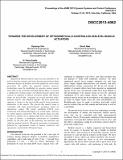Towards the Development of Optogenetically-Controlled Skeletal Muscle Actuators
Author(s)
Kim, Hyeonyu; Neal, Devin M; Asada, Haruhiko
Downloadv002t29a005-dscc2013-4062.pdf (2.910Mb)
PUBLISHER_POLICY
Publisher Policy
Article is made available in accordance with the publisher's policy and may be subject to US copyright law. Please refer to the publisher's site for terms of use.
Terms of use
Metadata
Show full item recordAbstract
Engineered skeletal muscle tissue has the potential to be used as dual use actuator and stress-bearing material providing numerous degrees of freedom and with significant active stress generation. To exploit the potential features, however, technologies must be established to generate mature muscle strips that can be controlled with high fidelity. Here, we present a method for creating mature 3-D skeletal muscle tissues that contract in response to optical activation stimuli. The muscle strips are fascicle-like, consisting of several mm-long multinucleate muscle cells bundled together. We have found that applying a tension to the fascicle-like muscle tissue promotes maturation of the muscle. The fascicle-like muscle tissue is controlled with high spatiotemporal resolution based on optogenetic coding. The mouse myoblasts C2C12 were transfected with Channelrhodopsin-2 to enable light (∼470 nm) to control muscle contraction. The 3D muscle tissue not only twitches in response to an impulse light beam, but also exhibits a type of tetanus, a prolonged contraction of continuous stimuli, for the first time. In the following, the materials and culturing method used for 3D muscle generation is presented, followed by experimental results of muscle constructs and optogenetic control of the 3D muscle tissue.
Date issued
2013-10Department
Massachusetts Institute of Technology. Department of Mechanical EngineeringJournal
Volume 2: Control, Monitoring, and Energy Harvesting of Vibratory Systems; Cooperative and Networked Control; Delay Systems; Dynamical Modeling and Diagnostics in Biomedical Systems; Estimation and Id of Energy Systems; Fault Detection; Flow and Thermal Systems; Haptics and Hand Motion; Human Assistive Systems and Wearable Robots; Instrumentation and Characterization in Bio-Systems; Intelligent Transportation Systems; Linear Systems and Robust Control; Marine Vehicles; Nonholonomic Systems
Publisher
ASME International
Citation
Kim, Hyeonyu, Devin Neal, and H. Harry Asada. “Towards the Development of Optogenetically-Controlled Skeletal Muscle Actuators.” Volume 2: Control, Monitoring, and Energy Harvesting of Vibratory Systems; Cooperative and Networked Control; Delay Systems; Dynamical Modeling and Diagnostics in Biomedical Systems; Estimation and Id of Energy Systems; Fault Detection; Flow and Thermal Systems; Haptics and Hand Motion; Human Assistive Systems and Wearable Robots; Instrumentation and Characterization in Bio-Systems; Intelligent Transportation Systems; Linear Systems and Robust Control; Marine Vehicles; Nonholonomic Systems (October 21, 2013).
Version: Final published version
ISBN
978-0-7918-5613-0